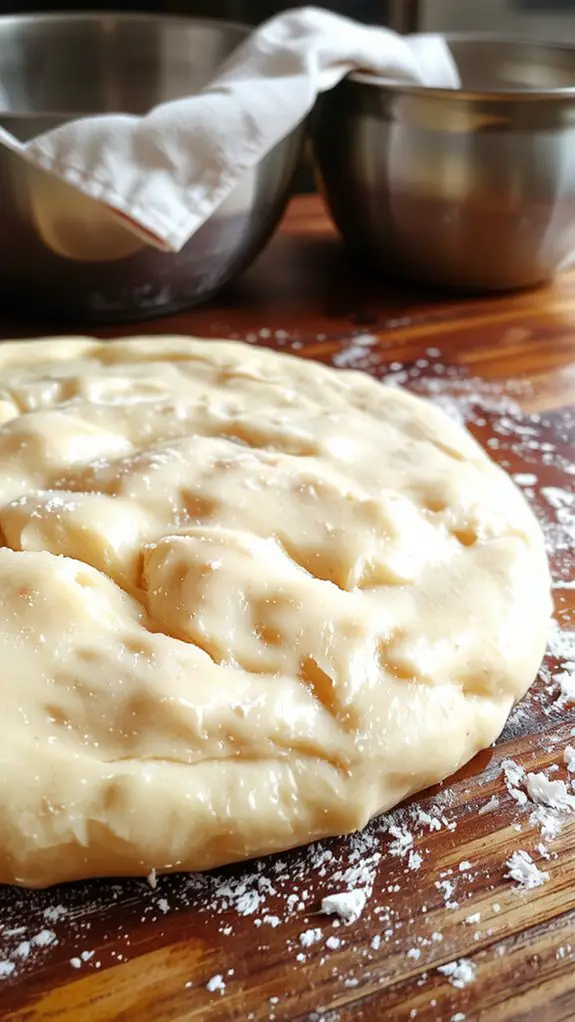Recipe
There’s nothing quite like the smell of freshly baked pizza dough filling your kitchen—crispy on the outside, chewy on the inside, and just begging to be topped with your favorite ingredients.
This homemade pizza dough recipe is my absolute go-to because it’s foolproof, versatile, and delivers that perfect balance of flavor and texture every single time. The secret? A simple mix of high-quality flour, a touch of honey for a hint of sweetness, and a slow rise that develops deep, yeasty flavor.
Whether you’re a pizza-making newbie or a seasoned pro, this dough will become your new staple—trust me, once you taste the difference, you’ll never go back to store-bought.
Let’s get kneading!
Ingredients
For the perfect homemade pizza dough, the right ingredients are essential to achieve that crispy yet chewy texture, just like your favorite pizzeria. High-quality flour, fresh yeast, and a bit of olive oil are the backbone of this recipe. Here’s what you’ll need, along with pro tips to elevate your dough game:
- All-purpose flour (or bread flour for extra chewiness) – Bread flour has higher protein content, giving your dough that perfect structure.
- Active dry yeast – Fresh yeast works too, but active dry yeast is easier to find and store. Make sure it’s not expired!
- Warm water – Around 110°F (43°C) is ideal to activate the yeast without killing it.
- Olive oil – Adds richness and helps crisp up the crust.
- Salt – Enhances flavor and strengthens the dough. Don’t skip it!
- Sugar (optional) – A pinch helps feed the yeast and adds a subtle sweetness.
Substitutions: Out of bread flour? Stick with all-purpose flour—it works great. No sugar? A teaspoon of honey or maple syrup is a delicious alternative.
Pro Tip: Preheat your oven with a pizza stone or baking steel inside for a crispy, restaurant-style crust. And always dust your surface with semolina flour for that authentic pizzeria texture.
These simple ingredients, when handled with care, will transform your homemade pizza into a masterpiece.
How to Make the Best Authentic Pizza Dough Formula

- Punch down the dough to release air bubbles, then divide and shape. Rest for 10 minutes before stretching—this relaxes gluten for easier handling.
- Preheat your oven and baking surface (stone or steel) to 500°F (260°C) for at least 30 minutes.
A hot surface mimics a pizza oven’s crisp-bottom magic.
– Top and bake for 10–12 minutes until the crust is golden.
Rotate halfway for even cooking. For a crispier crust, brush the edges with olive oil before baking.
Nutrition
This homemade pizza dough recipe provides essential nutrients to fuel your day. Here’s the nutritional breakdown per serving:
| Nutrient | Amount |
|---|---|
| Calories | 180 |
| Protein | 4g |
| Fat | 2g |
| Carbohydrates | 35g |
| Fiber | 1g |
| Sugar | 1g |
| Sodium | 300mg |
Chef Tips
When I’m making homemade pizza dough, I always make certain to use warm water—not hot—to activate the yeast.
I knead just until smooth—overworking makes it tough.
Letting it rise in a warm spot doubles its size for perfect texture.
I dust the surface with semolina for crispiness.
Preheating the oven with a pizza stone guarantees even baking. These small steps make all the difference.
Frequently Asked Questions
Can I Freeze the Dough?
Yes, I can freeze the dough. After it rises, I’ll divide it into portions, wrap each tightly in plastic wrap, and store in a freezer bag. It’ll last up to three months. Thaw in the fridge overnight.
How Long Does the Dough Keep in the Fridge?
I’ve found that the dough keeps well in the fridge for up to 3 days, though I’d use it within 2 for the best texture. I always cover it tightly to prevent it from drying out.
Can I Use Gluten-Free Flour?
Yes, I can use gluten-free flour, but I’ll need to adjust the recipe slightly. Gluten-free dough behaves differently, so I’d add a binding agent like xanthan gum and expect a different texture than traditional dough.
Is a Stand Mixer Necessary?
A stand mixer isn’t necessary, but it makes kneading easier. I’ve made dough by hand plenty of times—it just takes a bit more effort. If I don’t have one, I use my hands and it works fine.
What’s the Best Oven Temperature for Baking?
I preheat my oven to 475°F for a crispy crust. If I don’t have a pizza stone, I’ll crank it up to 500°F. Higher heat gives me that perfect golden-brown finish I’m always aiming for.






